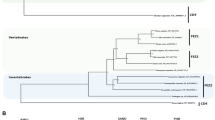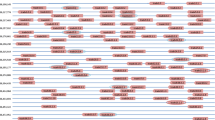Abstract
During T cell differentiation, medullary thymic epithelial cells (MTEC) expose developing T cells to tissue-specific antigens. MTEC expression of such self-antigens requires the transcription factor autoimmune regulator (Aire). In mammals, defects in aire result in multi-tissue, T cell-mediated autoimmunity. Because the T cell receptor repertoire is randomly generated and extremely diverse in all jawed vertebrates, it is likely that an aire-dependent T cell tolerance mechanism also exists in nonmammalian vertebrates. We have isolated aire genes from animals in all gnathostome classes except the cartilaginous fish by a combination of molecular techniques and scanning of expressed sequence tags and genomic databases. The deduced amino acid sequences of Aire were compared among mouse, human, opossum, chicken, Xenopus, zebrafish, and pufferfish. The first of two plant homeodomains (PHD) in human Aire and regions associated with nuclear and cytoplasmic localization are evolutionarily conserved, while other domains are either absent or divergent in one or more vertebrate classes. Furthermore, the second zinc-binding domain previously named Aire PHD2 appears to have greater sequence similarity with Ring finger domains than to PHD domains. Point mutations in defective human aire genes are generally found in the most evolutionarily conserved regions of the protein. These findings reveal a very rapid evolution of certain regions of aire during vertebrate evolution and support the existence of an aire-dependent mechanism of T cell tolerance dating back at least to the emergence of bony fish.





Similar content being viewed by others

Explore related subjects
Discover the latest articles and news from researchers in related subjects, suggested using machine learning.References
Ahonen P, Myllarniemi S, Sipila I, Perheentupa J (1990) Clinical variation of autoimmune polyendocrinopathy–candidiasis–ectodermal dystrophy (APECED) in a series of 68 patients. N Engl J Med 322:1829–1836
Anderson MS, Venanzi ES, Chen Z, Berzins SP, Benoist C, Mathis D (2005) The cellular mechanism of Aire control of T cell tolerance. Immunity 23:227–239
Bartl S, Baish MA, Flajnik MF, Ohta Y (1997) Identification of class I genes in cartilaginous fish, the most ancient group of vertebrates displaying an adaptive immune response. J Immunol 159:6097–6104
Bottomley MJ, Collard MW, Huggenvik JI, Liu Z, Gibson TJ, Sattler M (2001) The SAND domain structure defines a novel DNA-binding fold in transcriptional regulation. Nat Struct Biol 8:626–633
Bottomley MJ, Stier G, Pennacchini D, Legube G, Simon B, Akhtar A, Sattler M, Musco G (2005) NMR structure of the first PHD finger of autoimmune regulator protein (AIRE1). Insights into autoimmune polyendocrinopathy–candidiasis–ectodermal dystrophy (APECED) disease. J Biol Chem 280:11505–11512
Chang C, Norris JD, Gron H, Paige LA, Hamilton PT, Kenan DJ, Fowlkes D, McDonnell DP (1999) Dissection of the LXXLL nuclear receptor–coactivator interaction motif using combinatorial peptide libraries: discovery of peptide antagonists of estrogen receptors alpha and beta. Mol Cell Biol 19:8226–8239
Chen QY, Lan MS, She JX, Maclaren NK (1998) The gene responsible for autoimmune polyglandular syndrome type 1 maps to chromosome 21q22.3 in US patients. J Autoimmun 11:177–183
Felsenstein J (1989) PHYLIP—phylogeny inference package (version 3.2). Cladistics 5:164–166
Grishin NV (2001) Treble clef finger—a functionally diverse zinc-binding structural motif. Nucleic Acids Res 29:1703–1714
Hall TA (1999) BioEdit: a user-friendly biological sequence alignment editor and analysis program for Windows 95/98/NT. Nucleic Acids Symp Ser 41:95–98
Heino M, Peterson P, Kudoh J, Nagamine K, Lagerstedt A, Ovod V, Ranki A, Rantala I, Nieminen M, Tuukkanen J, Scott HS, Antonarakis SE, Shimizu N, Krohn K (1999) Autoimmune regulator is expressed in the cells regulating immune tolerance in thymus medulla. Biochem Biophys Res Commun 257:821–825
Heino M, Peterson P, Kudoh J, Shimizu N, Antonarakis SE, Scott HS, Krohn K (2001) APECED mutations in the autoimmune regulator (AIRE) gene. Hum Mutat 18:205–211
Ilmarinen T, Melen K, Kangas H, Julkunen I, Ulmanen I, Eskelin P (2006) The monopartite nuclear localization signal of autoimmune regulator mediates its nuclear import and interaction with multiple importin alpha molecules. FEBS J 273:315–324
Johnnidis JB, Venanzi ES, Taxman DJ, Ting JP, Benoist CO, Mathis DJ (2005) Chromosomal clustering of genes controlled by the aire transcription factor. Proc Natl Acad Sci USA 102:7233–7238
Klamp T, Sahin U, Kyewski B, Schwendemann J, Dhaene K, Tureci O (2006) Expression profiling of autoimmune regulator AIRE mRNA in a comprehensive set of human normal and neoplastic tissues. Immunol Lett 106:172–179
Kumar PG, Laloraya M, Wang CY, Ruan QG, voodi-Semiromi A, Kao KJ, She JX (2001) The autoimmune regulator (AIRE) is a DNA-binding protein. J Biol Chem 276:41357–41364
Kyewski B, Klein L (2006) A central role for central tolerance. Annu Rev Immunol 24:571–606
Mathis D, Benoist C (2007) A decade of AIRE. Nat Rev Immunol 7:645–650
Meloni A, Fiorillo E, Corda D, Perniola R, Cao A, Rosatelli MC (2005) Two novel mutations of the AIRE protein affecting its homodimerization properties. Hum Mutat 25:319
Mertz LM, Rashtchian A (1994) Nucleotide imbalance and polymerase chain reaction: effects on DNA amplification and synthesis of high specific activity radiolabeled DNA probes. Anal Biochem 221:160–165
Nair R, Carter P, Rost B (2003) NLSdb: database of nuclear localization signals. Nucleic Acids Res 31:397–399
Pitkanen J, Vahamurto P, Krohn K, Peterson P (2001) Subcellular localization of the autoimmune regulator protein. Characterization of nuclear targeting and transcriptional activation domain. J Biol Chem 276:19597–19602
Podkrajsek KT, Bratanic N, Krzisnik C, Battelino T (2005) Autoimmune regulator-1 messenger ribonucleic acid analysis in a novel intronic mutation and two additional novel AIRE gene mutations in a cohort of autoimmune polyendocrinopathy–candidiasis–ectodermal dystrophy patients. J Clin Endocrinol Metab 90:4930–4935
Schmutz J, Grimwood J (2004) Genomes: fowl sequence. Nature 432:679–680
Shiina T, Briles WE, Goto RM, Hosomichi K, Yanagiya K, Shimizu S, Inoko H, Miller MM (2007) Extended gene map reveals tripartite motif, C-type lectin, and Ig superfamily type genes within a subregion of the chicken MHC-B affecting infectious disease. J Immunol 178:7162–7172
The Finnish-German APECED Consortium (1997) An autoimmune disease, APECED, caused by mutations in a novel gene featuring two PHD-type zinc-finger domains. Nat Genet 17:399–403
Thompson JD, Gibson TJ, Plewniak F, Jeanmougin F, Higgins DG (1997) The CLUSTAL_X windows interface: flexible strategies for multiple sequence alignment aided by quality analysis tools. Nucleic Acids Res 25:4876–4882
Uchida D, Hatakeyama S, Matsushima A, Han H, Ishido S, Hotta H, Kudoh J, Shimizu N, Doucas V, Nakayama KI, Kuroda N, Matsumoto M (2004) AIRE functions as an E3 ubiquitin ligase. J Exp Med 199:167–172
Williamson MP (1994) The structure and function of proline-rich regions in proteins. Biochem J 297(Pt 2):249–260
Acknowledgments
This work has been funded by the NIH (R01AI27877).
Author information
Authors and Affiliations
Corresponding author
Electronic supplementary material
Below is the link to the electronic supplementary material.
Supplemental Fig. 1
cDNA sequence of X. tropicalis (X.t.) aire. The overhead line denotes overlap of one or more EST sequences. Primers underlined. Bold letters denote the probe region used in Northern blotting and cDNA library screening. Amino acid sequence of a partial X. laevis (X.l.) sequence aligned to the X. tropicalis sequence (PDF 132 kb)
Supplemental Fig. 2
Chicken genomic fragment amplified by PCR. The bold sequence corresponds to exons derived from PCR amplification of cDNA. Primers used for PCR amplification are underlined. Major splice junctions are denoted by black triangles. Minor splice junctions are denoted by gray triangles. A turkey genomic fragment is aligned for a portion of the chicken sequence. The sequence in the gray box is consistent with an identified microsatellite identified in the turkey suggesting an area of genomic instability (PDF 139 kb)
Supplemental Fig. 3
Zebrafish alignment to other teleost fishes. Aire from two species of pufferfish were reconstructed based on alignment to zebrafish Aire. Sequences were subsequently aligned using Clustal W followed by manual adjustment (PDF 116 kb)
Supplemental Fig. 4
Pairwise sequence identity comparison of the putative Aire amino acid sequences aligned by exon. For reference, the equivalent human domain is listed above each alignment. Bioedit (Hall 1999) was used to create sequence identity matrices (PDF 242 kb)
Rights and permissions
About this article
Cite this article
Saltis, M., Criscitiello, M.F., Ohta, Y. et al. Evolutionarily conserved and divergent regions of the Autoimmune Regulator (Aire) gene: a comparative analysis. Immunogenetics 60, 105–114 (2008). https://doi.org/10.1007/s00251-007-0268-9
Received:
Accepted:
Published:
Issue Date:
DOI: https://doi.org/10.1007/s00251-007-0268-9



